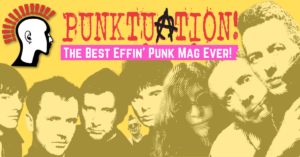Like elsewhere, Germany’s punk scene emerged in the mid-1970s. However, its beginnings are distinct from its US and UK punk cousins. Punktuation explores the history of Deutsche Punk.
Punk in Germany started at the time the scenes emerged across the USA and UK in 1976. So hungry were the West German teens for the latest sounds coming from the UK, some travelled to London to hunt out the new releases by The Damned, The Vibrators, and The Clash.
You were seen as pretty cool if you managed to get your hands on a Sex Pistols album or the latest Ramones LP. The word of this exciting new music spread fast around the rooms of West Germany’s teenagers.
In the mid-1970s, Germany was still a divided country; split between the two global blocs in the East and West.

The German Democratic Republic (GDR), commonly known as East Germany, was the smaller Marxist–Leninist socialist republic, dominated by the Soviet-aligned Socialist Unity Party of Germany (SED).
The Federal Republic of Germany (FRG) – West Germany – was a parliamentary democracy with a capitalist economic system, free churches and labour unions.
From these divided States two distinct punk movements grew.
The reasons why teens became punks in Germany varied. Teens in the West suffered from a mixture of pure boredom and frustration with the conservative oppression, and the East German teens wanted to fight against State oppression.

German youth on both sides of The Wall shared feelings of helplessness and hopelessness. They felt suffocated in the system and had trouble with authority figures – be it school, parents, capitalism in the West, the state in the East, and the police on both sides of the Iron Curtain.
In 1976 West German teen music magazine Bravo published posters of The Sex Pistols and The Ramones, a decision that unintentionally gave German teenagers ‘permission to rebel’!
Just by looking like Sid Vicious and drawing the Nazi swastika was enough to provoke the authorities and the older generations in both East and West Germany, something the disenfranchised youth from both sides of The Wall relished.

The German punk scene(s) wanted to break with everything oppressive and “old”. It was a DIY-chaos of diffused anarchistic worldviews that were very appealing to the frustrated German teens.
Punk in the Federal Republic of Germany (West Germany)
The first West German punk band Big Balls & The Great White Idiot, emerged in Hamburg in the winter of 1976. Male and Charley’s Girls from Düsseldorf, Pack from Munich, and PVC and Vorkriegsjugend from West Berlin followed.
The UK punk band the Vibrators played at Kant Kino club in West Berlin on February 25th 1977, and it was that gig that is said to have marked the unofficial birth of punk in West Germany. In his autobiography, Berlin.Punk.PVC – Die Unzensierte Geschichte (Berlin.Punk.PVC – The Uncensored History) the PVC guitar and vocalist Gerrit Meijer recalled meeting all his future bandmates at that gig.

Around the same time, Franz Bielmeier also started the first German punkzine The Ostrich in Düsseldorf.
“We wanted to be different, and we wanted to shock. We were against any kind of depth in music,” Bielmeier remembers.
The country’s ‘first punk’, Jäki Eldorado, (who was the bass player for bands such as Ivanhoe, Aus lauter Liebe, and the Nina Hagen Band and who also famously licked Iggy Pop’s leg during a Stooges gig in 1977 – “purely a publicity stunt,” according to Jäki, but one that would provide an iconic punk photo) was pissed off that most of the local punk bands at the time sang in English. He wanted to “bring the German language into punk music,” which he did. He later became the tour manager for punk bands Die Ärzte and Die Toten Hosen, among others.

The first Anti-Fascist Punk Festival took place in 1979 in Kreuzberg, West Berlin. The event included many interesting and political performances, including one the all-female anarcho-punk band Ätztussis.
The punks in the West mainly hung out at Punkhouse, SO36 and KZ36 clubs in West Berlin, Markthalle and Krawall 2000 in Hamburg, and Ratinger Hof in Düsseldorf.
Punk in the Deutsche Demokratische Republik (East Germany)
Punks in East Germany were seen by the state’s secret police, the Stasi, as a subversive anti-government force that needed to be destroyed. Needless to say, punk in East Berlin and DDR had to remain underground.

The Socialist Unity Party of Germany (SED) officials frequently harassed the punks and infiltrated punk bands with Stasi informants. The only places punks could gather were private houses and, ironically enough – at the Evangelical or Catholic Church premises.
Major punk centres in the former DDR were East Berlin, that was the home of bands such as Namenlos, Planlos, Feeling B, and Die Skeptiker. The city of Dresden was the home of punk band Paranoia, Leipzig had L’Attentat and Wutanfall, and the Erfurt area Schleimkeim.
After many violent run-ins with the Stasi, the first punk festival in DDR was held in April 1983 under the cover name The Evening of the Evangelical Youth. The first East German punk album DDR von unten featuring bands Zwitschermaschine and Schleimkeim, was released that same year on the West German punk label Aggressive Rockproduktionen.
In June 1984, West Germany’s Die Toten Hosen crossed into East Berlin to play a secret gig. The band’s lead singer Campino remembers how they all had to disguise themselves.
“We combed our hair and got proper clothes on to cross the West-East border. Punk rock didn’t officially exist in the East; they didn’t want to spread this virus in any form,” he remembers.
In 1986 Berlin radio host and journalist Lutz Schramm worked for East German broadcaster DT64 and he aired punk music for the first time in East Germany on the youth radio show – Parocktikum. Two years later, DDR record label Amiga started releasing what they labelled “die anderen bands” (the other bands).
In 1989 the Berlin Wall fell and the country was finally reunited. The punk spirit lived on and new bands like Terrorgruppe, Knochenfabrik, 100 Kilo Herz, Kotzreiz and others emerged in the freshly reunited Germany.
However, following the fall of The Wall, the German punk music scene started to change due to the emerging presence of neo-Nazi political groups across the country.
In opposition to the frightening rise of Nazism in Germany, the punk scene became more hardcore and far more political.
The legacy of the early German punk scene can still be felt today. Punk festivals are still big across the country, and punk fashion continues to permeate street style and the underground clubbing scenes in cities like Berlin.
Deutsche Punk is certainly not dead! It’s very much alive and kicking and a force to be reckoned with! Es lebe Punk!
COMING SOON… Punktuation’s Top Ten German Punk band!
Need More Punk Reads?
Berlin-based drummer from Belgrade, Serbia. Nerd, former political scientist, cakes and concert junkie. Currently studying Music Business at SAE Institute. Great at memes and political incorrectness. Passionate about writing and all things punk.
Click on Teejay’s photo for more of her articles!




 Did you know that we are 100% DIY? We run our own game. No one dictates to us, and no one drives what we can or cannot put on our pages – and this is how we plan to continue!
Did you know that we are 100% DIY? We run our own game. No one dictates to us, and no one drives what we can or cannot put on our pages – and this is how we plan to continue!
